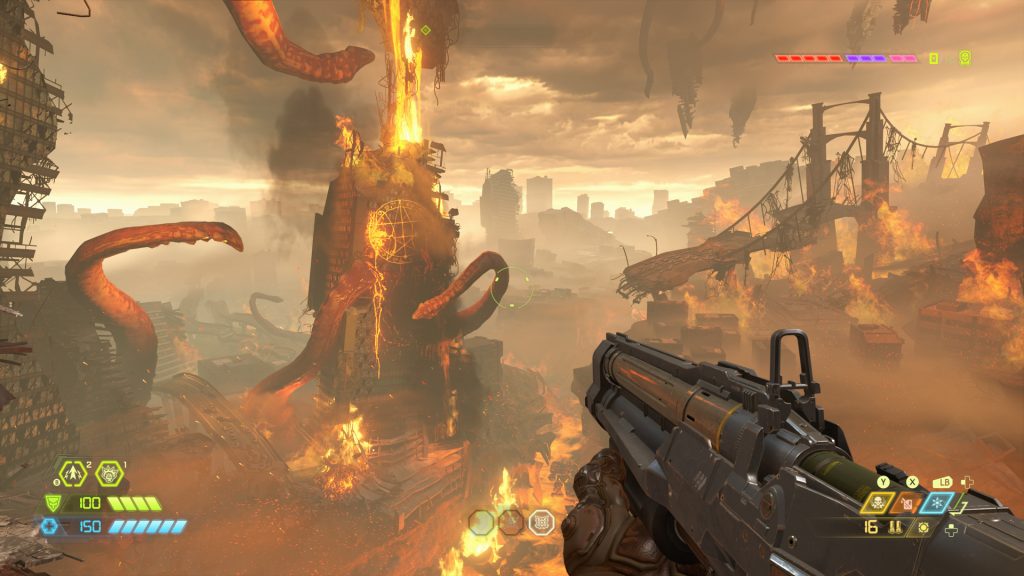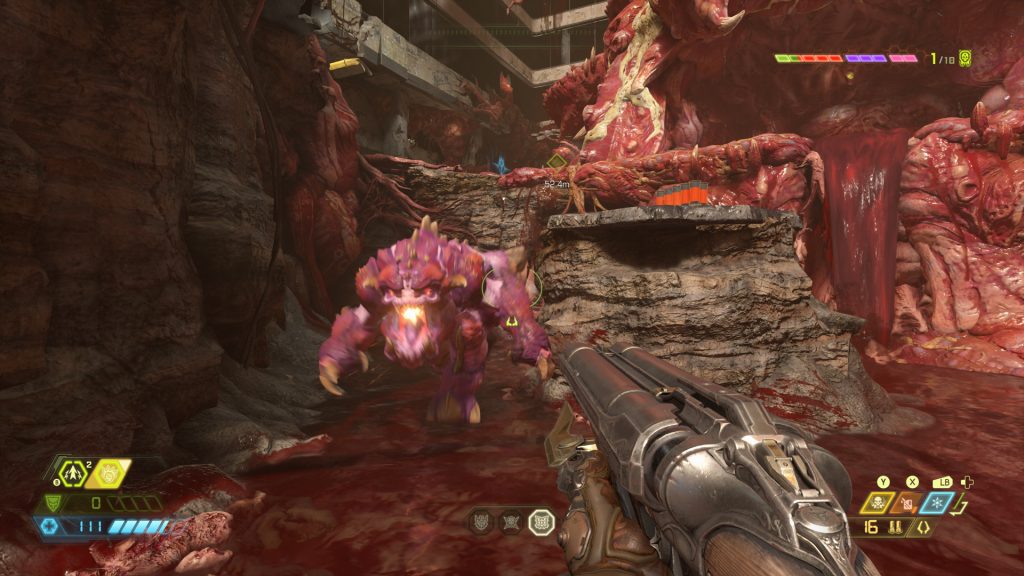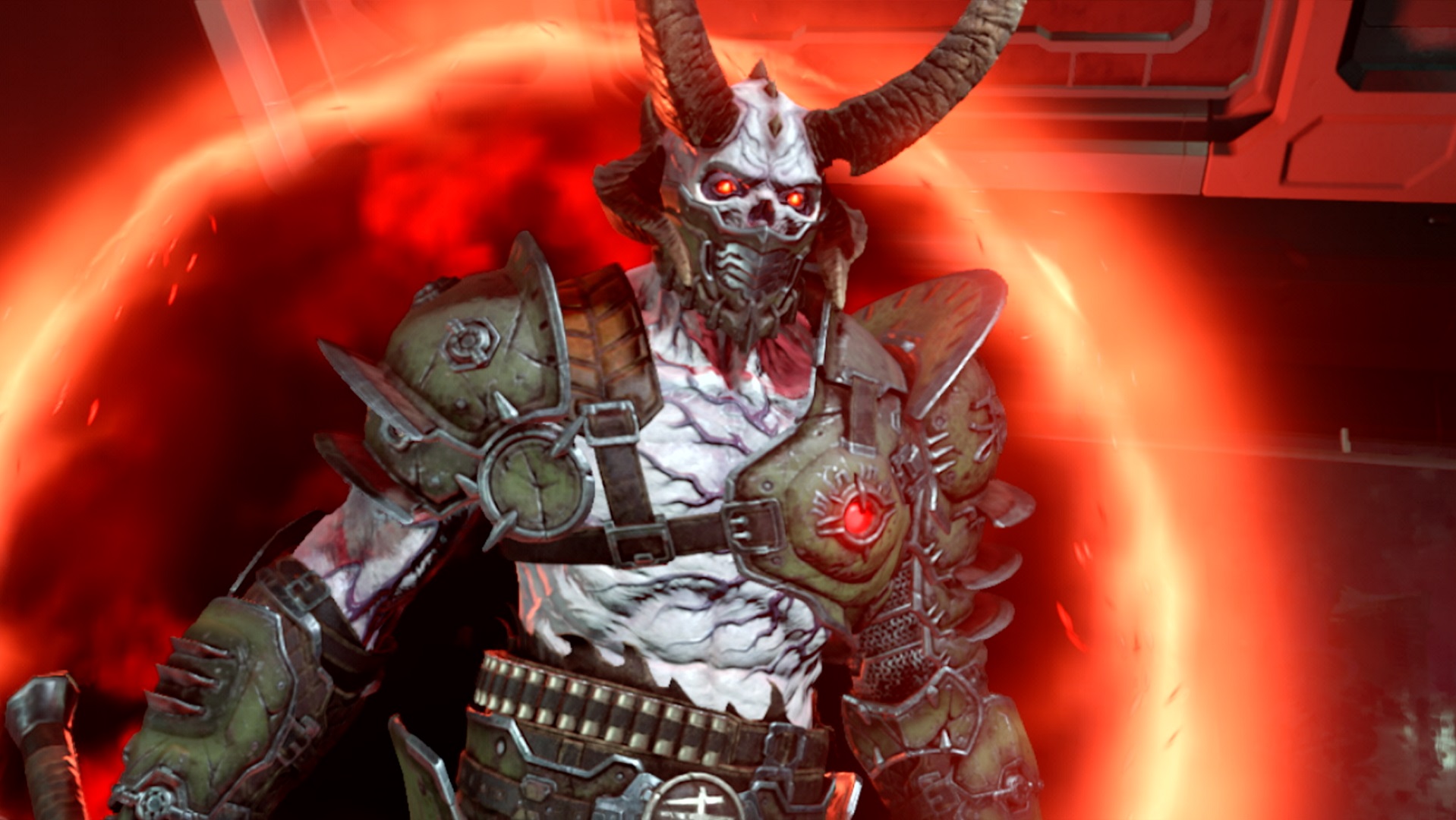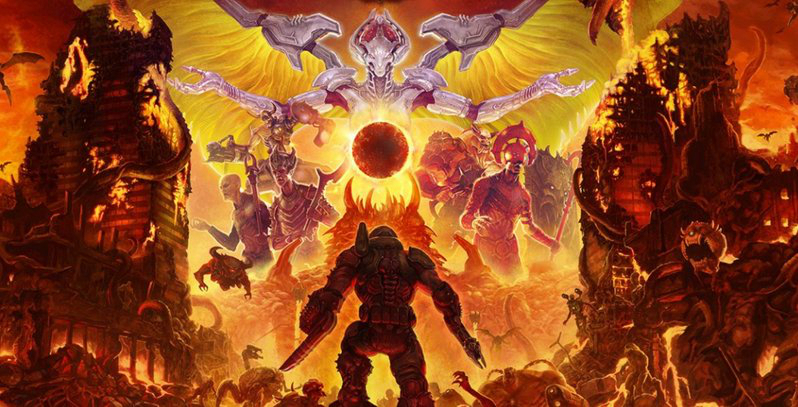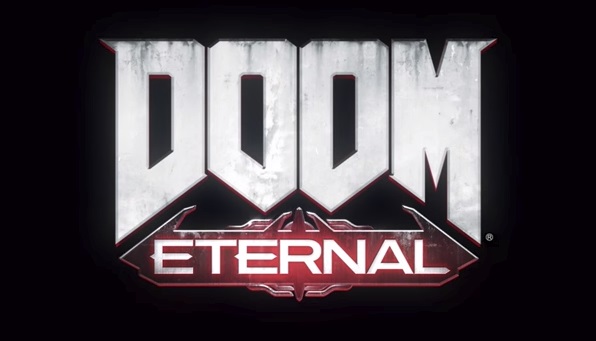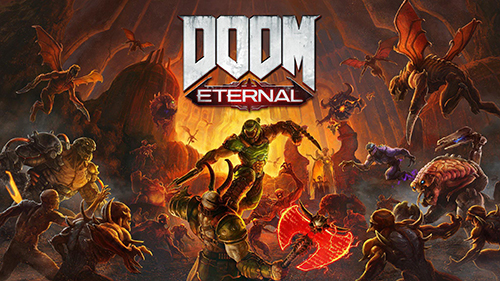
Rip and tear. Those opening words echoed in players’ ears as they started id Software’s 2016 Doom reboot, and those same words open its long-awaited sequel, Doom Eternal. They’re well chosen, the visceral imagery they evoke is fully in-line with what awaits players, as Doom Eternal is a full-bore train-ride into blood, gore and over-the-top violence fueled by the desire to see more, not because it’s mean spirited or disgusting, but because of just how metal it is. In doubling down on everything that not only made Doom (2016) work, but the original classic games, id Software has come away with the most fun shooter I’ve played in a long time.
The most important thing to know is Doom Eternal is buttery smooth. The framerate holds at a steady 60fps on Xbox One X (which this review played), but beyond that the actual mechanics of the game are a thing of beauty. Not only is the Doom Slayer equipped with a double jump, he also has a double dash. These two mechanics alone make strafing around enemies, or vaulting over them to get an edge, easier than ever. But wait – there’s more. The Doom Slayer can volley off flagpoles for extra distance, use a Super Shotgun attachment to hookshot onto enemies and reel himself in. The level design is built beautifully to play off all of this as well, as you move from arena to arena, with each one’s structure alone being good enough for a solid multiplayer map. There are launch pads to leap from, ledges to scramble up in escape, corridors to regroup and pathways to mount huge counterattacks.
The gunplay is excellent, with a range of powerful weapons that all have have impact, and pretty rad ways to modify them. The pistol has been pissed off from the start of the game, instead starting you out with the combat shotgun and chainsaw, before introducing the heavy rifle, plasma rifle, super shotgun and more. Each weapon can be modified to have some pretty powerful effects, like slicing through rows of enemies with a single beam, or firing sticky grenades or microwave beams, which can be modified further to ‘mastery’ for some truly overpowered effects. As in the last Doom, glory killing enemies yields health, and chainsawing enemies yields ammunition. However, a new addition is the ‘flame belch’, a flamethrower sets enemies alight who can then be juiced for armor pickups, provided you keep firing at them. With all three key pick-ups now covered, combat is a lot more interesting strategically, as you have to constantly monitor what you’re in need of and where it’s going to come from, which can change in a heartbeat. Do you lure a group of zombies into a small crowd and light them on fire for armor? Or do you toss a frag grenade to keep a larger enemy busy, while you chainsaw a demon for ammunition? Rather than head straight into the fray to start stockpiling pick-ups, do you stay back initially to target enemy weak points with your heavy rifle’s sniper mode? Have you glory-killed enough guys to charge up your blood punch, which can take out a whole group of enemies with your next melee hit? There’s more dynamism in the combat than ever before, allowing for more experimentation in the core gameplay loop, especially when combined with your array of movement options.
Despite improving on its predecessor in every way, at times, Doom Eternal does feel like a throwback, although it feels enjoyably intentionally so. Progressing from an area is often just a matter of clearing out every enemy, before one just happens to clear an exit you need to progress in the level. That said, it does still find ways to pull the rug out from under you – one memorable moment involves spending the entirety of two levels building up the ultimate anti-Doom Slayer boss battle, which is every bit as teeth-clenching and blood-pumping as you’d expect. What happens immediately after, which I won’t spoil, doubles down on it quite literally.
The story of Doom Eternal picks up more or less where Doom left off. The heroic Doom Slayer, a member of an ancient order forever at war with demonic forces, battled through an invasion of Hell on a research base at Mars, although he was prevented from fully completing the job by the machinations of the UAC corporation. Now, the UAC’s further dallying with unknown forces and their manipulation by them, has unleashed Hell on Earth – Earth visibly scorched from space with continent-wide satantic marks, as humanity has been brought to the brink of extinction. Rocking up in his orbiting space cathedral, the Doom Slayer begins his work freeing Earth from Hell’s influence by destroying three Priests keeping the portals open, although his journey takes him to many places, and realms, meeting a whole host of bad guys to literally tear apart.
The design of the world Doom Eternal crafts is stunning, to say the least. Of course, much of the scenario will be familiar to fans of Doom II, and its incredible how much Doom Eternal does feel like that game, as well as the classic series as a whole, especially in its early stages where gothic corridors and maze-like arenas bring back flashes of the 90’s. As the world opens up, you get larger glimpses of the war between the forces of Hell and Earth, with enormous burning cityscapes under attack from eldritch entities, gigantic mechs frozen in battle against titanic demons, the glacial of gothic cult base. You could take a screenshot from any of the game’s setpieces and use it as an album cover for a metal album. There’s also humour, especially in the Doom Slayer’s space-church headquarters, which seem to imply he spends most of his free time sitting on a throne reading comic books and playing with his Pop! figures while strumming on one of his many axe guitars. Zoned damage is also visible on all enemies, especially so on zombies as each bullet picks away at the specific flesh you fire at, which is just lovely.
The visual design, along with the files you find strewn around the game, build up into a unique version of the lore that id goes balls-deep into for Doom Eternal. This universe of the demonic, angelic, magical and sci-fi blends together in a way that feels right for this series, although I won’t spoil the surprises in store.
On top of weapon modification, there’s an array of upgrade trees and collectibles that actually start to get a little too much. Your suit can be upgraded with up to three ‘runes’ at a time, with functions like greater air maneuverability or the ability to slow time while falling. Your health, ammo, and armor can all be upgraded individually – although if you do them in certain combinations they can unlock further perks such as increasing the range pick-ups are drawn to you. There’s also a skill wheel for the Doom Slayer’s ‘Praetor Suit’ which allows further upgrades to basic movement, environment interaction and the effects of your frag and freeze grenades. On top of that, the entirety of Doom Slayer’s base can be steadily unlocked with batteries, which yields more materials for upgrades. There are also secret challenges hidden throughout the levels – short encounters that require a certain amount of skill to pass – on top of ‘Slayer Gates’ which open to areas with even greater combat challenges, which can then unlock an even more secret challenge. There’s a lot to keep track of, so much that you would be forgiven for ignoring some of it on your initial playthrough, as it sometimes feels like there’s just one too many systems at play that could have been streamlined. However, the amount of challenges and collectibles (which include original id Software music tracks and cheat codes) in every level means there is enormous value in replaying every level and exploring every nook and cranny.
Doom Eternal feels like id Software went all-in on cramming all of their best ideas for the ultimate Doom experience into one game. There’s so much to play, re-play, collect, perfect and murder, that it’s a game that will keep me coming back for a long time. It looks great, plays like silk and it’s just fucking metal.
- Doubles down on everything that worked in 2016's Doom - Metal-as-fuck visuals, constantly impressive and inventive - Buttery smooth combat that feels like a throwback yet is unlike anything else - Killer soundtrack
- Almost too many upgrade systems and customisation options threaten to confuse what feels like it should be more straightforward

